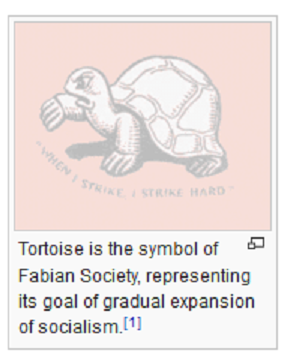The Fabian strategy takes its name from Quintus Fabius Maximus Verrucous, the Roman dictator given the task of defeating the great Carthaginian General Hannibal in southern Italy during the Second Punic War (218-201 BC). Essentially, the Fabian strategy is a military strategy where grand battles and frontal assaults are avoided in favor of wearing down an opponent through a war of attrition and indirection. 
The party employing the Fabian strategy believes that time is on its side and badgers the enemy through skirmishes to cause attrition, disrupt supply lines and debilitate morale. To defeat Hannibal, Fabius avoided engaging him in grand battles to deprive Hannibal the propaganda value of major victories and to wear down his endurance. In American history, General George Washington made good use of the Fabian strategy to harass the British, and in Russia the Fabian strategy was used against Napoleon’s Grand Armée.
In 1884, the Fabian Society was founded in London with the explicit goal of advancing socialism via gradual reforms in democracies rather than by revolutionary overthrow. To this day, the Fabian Society exerts significant influence in British politics, for example, former Prime Minister Tony Blair is a member. The Society’s logo is a tortoise representing the group’s preference for a slow, unnoticeable transition to socialism. Interestingly, the original coat of arms of the Fabian Society was a wolf in sheep’s clothing indicating the group’s strategy for achieving its goals.
In the period between the two World Wars, many future world leaders, such as India’s Jawaharlal Nehru, were captivated by Fabian ideas. Later, these leaders framed the economic policies of their countries along Fabian socialist lines of state-owned enterprises in key economic sectors such as telecommunications, transportation, electricity, mining, and more. These Fabian socialist leaders also demonized private property and entrepreneurship through high taxes, onerous regulations, permits, and nationalizations.
Classic Marxist socialism relies primarily in a revolutionary Leninist strategy as exemplified by armed revolutions in Russia, China, Cuba, and elsewhere. In contrast, Fabian socialism wants to reach the same socialist goals through evolutionary or parliamentary processes. But, just like revolutionary socialism, Fabian socialism envisions a complete economic, political, and social restructuring of society. Fabian socialists have no objection to the sociopolitical and economic restructuring desired by revolutionary socialists, they just prefer a different method of bringing about a socialist society.
Today, we find Fabian-style politicians like Bernie Sanders and Alexandria Ocasio-Cortez who advocate for a socialist transformation in the United States. Often these politicians use Sweden as their model of a supposedly socialist country. And indeed, Sweden did experiment with a heavy dosage of socialist policies in the 1970s and 1980s. The policies of that time period gave Sweden its reputation as a socialist country of high taxes, extensive regulations, and generous government programs.
However, that Swedish socialist experiment failed, and the country found itself with myriad socioeconomic problems. At one point, the Swedish National Bank had an interest rate of 500 percent to defend the Swedish currency. In a life-imitates-fiction moment, Sweden reminded us of Atlas Shrugged as many of its entrepreneurs and influencers left the country (Johan Norberg).
Representative Ocasio-Cortez and Senator Sanders should update their model, because Sweden wisely reversed course during the last two decades. Today, far from a socialist country, Sweden is a free market economy with libertarian-like policies such as private pension accounts, a school voucher system with freedom of choice, low corporate taxes, and no taxes on wealth, property, or inheritance.
Swedish scholar Johan Norberg notes that polls in Sweden show that only ten percent say they are socialist. Ironically, according to a Gallup poll, 57 percent of American Democrats, and 16 percent of Republicans have a positive attitude toward socialism. Accordingly, it appears that there are more socialists in the U.S. Republican Party than in Sweden.
It is unlikely, in our times, that we will see a turn to revolutionary socialism in any developed country. However, socialism is advancing with a Fabian strategy of a slow, unnoticeable transition to socialism within a democratic framework; just as designed by the Fabian Society’s coat of arms of a wolf in sheep’s clothing.
Comments powered by CComment